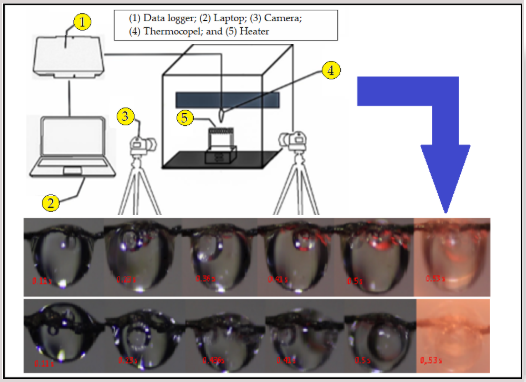Main Article Content
Abstract
Utilization of crude palm oils (CPO) as biodiesel faces difficulty due to their high level of viscosity. Mixing crude eucalyptus oils (CEO) with CPO may reduce the viscosity due to the presence of aromatic compounds in CEO. The single droplet analysis was performed to determine the characteristics of mixing CPO with the CEO. The results showed that the addition of CEO decreased the viscosity due to the presence of intermolecular attractions, thereby leading to more active molecules in the CPO-CEO mixture. Furthermore, the aromatic compound in the CEO helped in decreasing the CPO flash point, while the aromatic compound in the triglyceride molecule weakens the bonds between molecules. The addition of CEO to CPO tends to reduce the ignition delay due to the presence of cineol content in the CEO, which weakens the van der Waals bond in CPO.
Keywords
Article Details

This work is licensed under a Creative Commons Attribution-NonCommercial 4.0 International License.
References
- R.D.Misra, M.S. Murthy, “Blending of additives with biodiesels to improve the cold flow properties, combustion and emission performance in a compression ignition engine - A review,” Renewable and Sustainable Energy Reviews, vol. 15, no. 5, pp. 2413–2422, 2011. doi:10.1016/j.rser.2011.02.023.
- H. M. Mahmudul, F. Y. Hagos, R. Mamat, A.A. Abdullah, “Impact of oxygenated additives to diesel-biodiesel blends in the context of performance and emissions characteristics of a CI engine,” in IOP Conf Ser Mater Sci Eng, 160, pp. 149–1458, 2016. doi:10.1088/1757-899X/160/1/012060.
- N. Yilmaz, “Performance and emission characteristics of a diesel engine fuelled with biodiesel-ethanol and biodiesel-methanol blends at elevated air temperatures,” Fuel, vol. 94, pp. 440–443, April 2012. doi:10.1016/j.fuel.2011.11.015.
- A. Sarin, R. Arora, N. P. Singh, R. Sarin, R. K. Malhotra, M. Sharma, A. A. Khan, “Synergistic effect of metal deactivator and antioxidant on oxidation stability of metal contaminated Jatropha biodiesel,” Energy, vo. 35, no. 5, pp.2333–2337, 2010. doi:10.1016/j.energy.2010.02.032.
- T. T. Kivevele , M.M. Mbarawa, A. Bereczky, T. Laza, J. Madarasz, “Impact of antioxidant additives on the oxidation stability of biodiesel produced from Croton Megalocarpus oil,” Fuel Processing Technology, vol. 92, no. 11, pp. 1244–1248, 2011. doi:10.1016/j.fuproc.2011.02.009.
- A. Kadarohman, H. Hernani, F. Khoerunisa, R. M. Astuti, “A potential study on clove oil, eugenol and eugenyl acetate as diesel fuel bio‐additives and their performance on one cylinder engine,” Transport, vol. 25, no.1, pp. 66–76, 2010. doi:10.3846/transport.2010.09.
- T. F. Yusaf, B. F. Yousif, M. M. Elawad, “Crude palm oil fuel for diesel-engines: Experimental and ANN simulation approaches,” Energy, vol. 36, pp. 4871–4878, 2011. doi:10.1016/j.energy.2011.05.032.
- A. Hoxie, R. Schoo, J. Braden, “Microexplosive combustion behavior of blended soybean oil and butanol droplets,” Fuel, vol. 120, pp. 22–29, 2014. doi:10.1016/j.fuel.2013.11.036.
- A. Demirbas. Relationships derived from physical properties of vegetable oil and biodiesel fuels,” Fuel, vol. 87, pp. 1743–1748, 2008. doi:10.1016/j.fuel.2007.08.007.
- A. Dhar, A. K. Agarwal, “Effect of Karanja biodiesel blend on engine wear in a diesel engine,” Fuel, vol. 134, pp. 81–89, 2014. doi:10.1016/j.fuel.2014.05.039.
- C.H. Wang, S. Y. Fu, L. J. Kung, C. K. Law, “Combustion and microexplosion of collision-merged methanol/alkane droplets,” Proceedings of the Combustion Institute, vo. 30, no. 2, pp. 1965–1972, 2005. doi:10.1016/j.proci.2004.08.111.
- G. S. Jackson, C. T. Avedisian, “The Effect of Initial Diameter in Spherically Symmetric Droplet Combustion of Sooting Fuels,” Proc R Soc A Math Phys Eng Sci, vol. 446, no. 1927, pp.255–276, 1994. doi:10.1098/rspa.1994.0103.
- E. Marlina, W. Wijayanti, L. Yuliati, I. N. G. Wardana, “The role of pole and molecular geometry of fatty acids in vegetable oils droplet on ignition and boiling characteristics,” Renewable Energy, vol. 145, pp. 596–603, 2020. doi:10.1016/j.renene.2019.06.064.
- E. Marlina, I. N. G. Wardana, L. Yuliati, W. Wijayanti, “The effect of fatty acid polarity on the combustion characteristics of vegetable oils droplets,” in. IOP Conference Series: Materials Science and Engineering, 2019. doi:10.1088/1757-899X/494/1/012036.
- M. Lapuerta, O. Armas, J. Rodríguez-FernándezJ, “Effect of biodiesel fuels on diesel engine emissions,” Progress in Energy and Combustion Science, vo. 34, no. 2, pp. 198–223, 2008. doi:10.1016/j.pecs.2007.07.001.
- N. D. D. Carareto, C. Y. C. S. Kimura, E. C. Oliveira, M. C. Costa, A. J. A. Meirelles, “Flash points of mixtures containing ethyl esters or ethylic biodiesel and ethanol,” Fuel, vol. 96, pp. 319–326, 2012. doi:10.1016/j.fuel.2012.01.025.
- A. Kadarohman, H. Hernani, I. Rohman, R. Kusrini, R. M. Astuti, “Combustion characteristics of diesel fuel on one cylinder diesel engine using clove oil, eugenol, and eugenyl acetate as fuel bio-additives,” Fuel, vol. 98, pp. 73–79, 2012. doi:10.1016/j.fuel.2012.03.037.
- I. N. G. Wardana, “Combustion characteristics of jatropha oil droplet at various oil temperatures,” Fuel, vol. 89, pp. 659–664, 2010. doi:10.1016/j.fuel.2009.07.002.
- V. Dee, B. D. Shaw, “Combustion of propanol-glycerol mixture droplets in reduced gravity,” Int J Heat Mass Transf, vol. 47, pp. 4857–4867, 2004. doi:10.1016/j.ijheatmasstransfer.2004.05.025.

